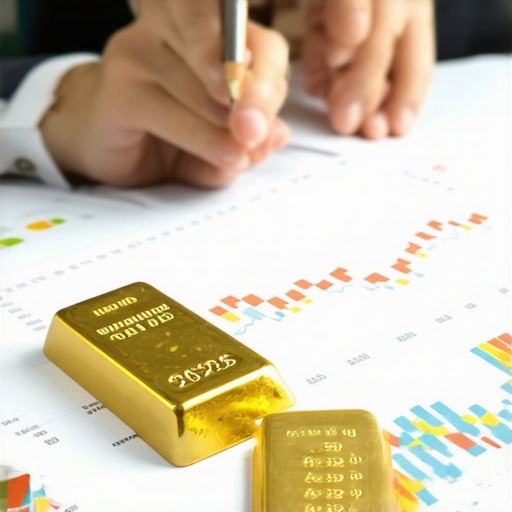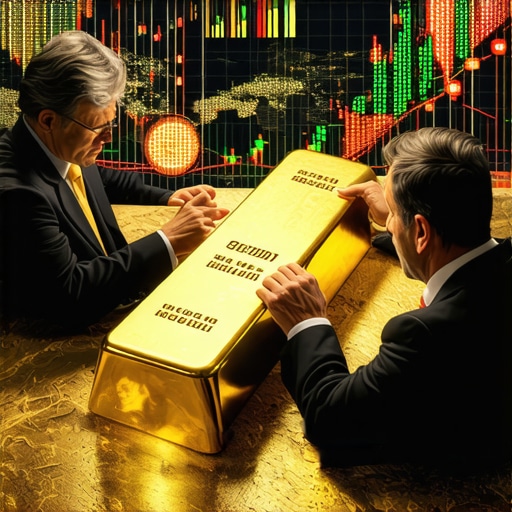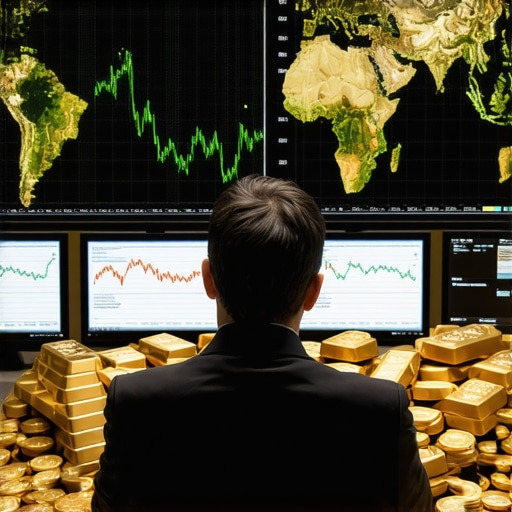Decoding the Future: How Emerging Gold Demand Trends Will Shape 2025 Market Dynamics
As financial markets evolve amidst global economic uncertainties, understanding the intricate patterns of gold demand becomes crucial for investors and policymakers alike. The year 2025 is poised to witness significant shifts driven by technological advancements, geopolitical tensions, and evolving consumer preferences, all of which influence gold’s price trajectory. In this analysis, we delve into the complex web of demand drivers and their potential impact on gold prices in 2025, informed by current trends and expert projections.
Technological Innovation and Digital Asset Adoption: New Frontiers for Gold Demand
One of the most compelling emerging trends is the integration of gold in digital assets and blockchain technology. As the financial industry explores decentralized finance (DeFi) and tokenized gold, demand from tech-savvy investors is expected to rise. According to recent research from the Journal of Gold Economics, digital gold products could account for a significant share of total demand, especially among younger demographics seeking liquidity and transparency.
Geopolitical Tensions and Reserve Reallocations: A Catalyst for Price Volatility
Geopolitical conflicts, especially involving major reserve-holding nations like China and Russia, continue to influence central bank gold purchases. As these countries diversify their reserves away from US dollar dependence, their strategic accumulation of gold acts as both a hedge and a signal for market expectations. The increased central bank activity is likely to introduce heightened volatility, making gold a more complex but potentially rewarding asset for institutional investors.
Consumer Demand and Jewelry Industry Dynamics in a Post-Pandemic World
Post-pandemic recovery has spurred renewed interest in physical gold, particularly coins and bars, driven by consumer preferences for tangible assets. The jewelry sector remains a vital component of gold demand, with emerging markets like India and China leading consumption. Fluctuations in jewelry demand, influenced by shifts in disposable income and cultural trends, will continue to impact supply-demand dynamics in 2025.
What complex factors could undermine or bolster gold’s role as a safe haven in volatile markets?
This question is frequently discussed among market analysts and requires a nuanced understanding of macroeconomic indicators, inflation trajectories, and monetary policy directions. For a comprehensive understanding, explore our detailed gold price forecast for 2025.
Investors should also consider diversifying their portfolios with gold ETFs and mutual funds to hedge against market unpredictability. The interplay of technological innovation, geopolitical strategy, and consumer behavior makes the landscape of gold demand in 2025 uniquely complex and ripe for strategic planning.
To stay ahead, professionals are encouraged to continuously analyze market reports and contribute insights based on emerging data. For further expert guidance, visit our beginner’s guide to gold investing and deepen your understanding of market fundamentals.
Unraveling the Nuances of Gold Demand in 2025: Beyond Surface Trends
As we venture deeper into 2025, analysts and investors face the challenging task of deciphering complex demand signals that influence gold prices. While traditional factors like geopolitical tensions and consumer demand remain significant, emerging dimensions such as environmental sustainability and technological innovation are reshaping the landscape. Understanding these nuanced drivers can empower investors to craft more resilient portfolios and capitalize on upcoming opportunities.
Environmental Sustainability and Ethical Mining: New Demand Catalysts
One of the less obvious but increasingly impactful forces is the rising emphasis on sustainable and ethically sourced gold. Investors are now scrutinizing supply chains for environmental impact, pushing demand for certified ‘green’ gold. According to a recent report from The World Gold Council, sustainable gold products are projected to grow significantly, driven by consumer preference shifts and stricter regulatory standards. This trend not only influences demand but also impacts supply dynamics, as miners adopt cleaner practices to meet ethical standards.
Technological Disruption and Market Accessibility
Technological advancements continue to democratize gold investment, making it accessible to a broader demographic. Blockchain-based platforms facilitate peer-to-peer trading and fractional ownership, reducing entry barriers. This technological disruption is likely to increase demand from retail investors seeking liquidity and transparency. Furthermore, digital gold offerings and tokenized assets are poised to capture a larger share of the market, as highlighted by industry experts in our comprehensive gold price forecast for 2025.
How might the convergence of sustainability initiatives and technological innovation redefine gold’s role as a safe haven in volatile markets?
This question highlights the need for strategic foresight among investors. The integration of eco-friendly practices within the mining industry, coupled with technological platforms enabling easier access, could significantly influence demand patterns. For instance, the increased adoption of certified sustainable gold could bolster consumer confidence and demand stability, while technological innovations might streamline trading and storage, reducing costs and barriers. To explore these topics further, consider reviewing our best gold coins and bars for wealth preservation in 2025.
Moreover, understanding the interplay between these factors and macroeconomic policies is crucial. Central banks’ evolving stance on gold reserves, combined with international efforts to promote responsible mining, will shape the demand landscape. For a detailed analysis, our market analysis of demand drivers offers valuable insights.
Finally, engaging with community discussions and sharing insights can provide a broader perspective. Feel free to comment below with your thoughts on how sustainability and technology might influence gold investments or share this article with fellow investors seeking to deepen their market understanding.
Harnessing Ethical Mining Innovations to Sustain Gold’s Safe Haven Status in 2025
As the global consciousness shifts toward environmental responsibility and social equity, the gold industry faces both challenges and opportunities. The push for sustainable and ethically sourced gold is transforming supply chains and reshaping demand dynamics, with profound implications for investors and industry stakeholders alike.
Recent advancements in environmentally conscious mining techniques, such as the adoption of renewable energy sources and water recycling, are setting new standards for responsible mineral extraction. According to The World Gold Council, these initiatives are not only reducing ecological footprints but also enhancing market appeal to ethically minded consumers and institutional investors increasingly prioritizing ESG (Environmental, Social, and Governance) criteria.

Why is the shift toward sustainable gold critical for maintaining its status as a safe haven?
Investors seeking stability are sensitive to risks associated with environmental degradation, regulatory backlash, and community opposition, which can destabilize supply and inflate costs. Sustainable practices mitigate these risks, fostering a more resilient and transparent supply chain that bolsters investor confidence. Moreover, certified green gold often commands premium prices, incentivizing miners to adopt cleaner technologies, which, in turn, sustains long-term demand.
Furthermore, regulatory frameworks are evolving to favor ethically produced gold. Countries like Switzerland and Canada are implementing stricter standards that favor certified sources, further integrating sustainability into the core of gold market operations. This regulatory alignment not only safeguards environmental and social interests but also helps stabilize prices by reducing illicit and environmentally damaging mining activities.
For investors, understanding these shifts is vital. Engaging with certified sustainable gold products and supporting companies committed to ESG principles can serve as both a moral choice and a strategic hedge. Financial instruments such as ESG-focused gold ETFs are increasingly popular, providing diversified exposure aligned with ethical standards.
The Convergence of Technology and Sustainability: Redefining Market Accessibility and Demand
The integration of blockchain technology and digital platforms is revolutionizing gold trading and ownership, making ethically sourced gold more accessible and transparent. Tokenization of gold allows fractional ownership, enabling retail investors to participate in the market with minimal entry barriers. This democratization aligns with the broader sustainability movement, as it encourages responsible consumption and reduces the reliance on physical storage and transportation, which are significant sources of environmental impact.
Leading industry players are investing in blockchain solutions that track the provenance of gold from mine to market, ensuring authenticity and ethical compliance. Such traceability not only satisfies consumer demand for transparency but also enhances market confidence, attracting a new wave of investors who prioritize sustainability alongside financial returns.
Can technological innovations in traceability and digital ownership truly redefine gold’s role as a resilient asset in volatile markets?
This nuanced question invites exploration into how technological advances can bolster gold’s reputation. Reliable traceability can mitigate fraud and provenance concerns, fostering trust in ethically certified gold. Meanwhile, digital ownership platforms reduce physical transaction costs and improve liquidity, making gold a more versatile safe haven asset. As these technologies mature, they could further solidify gold’s position as the quintessential hedge against macroeconomic volatility, especially when aligned with sustainability standards.
To deepen your understanding and stay ahead of emerging trends, explore our detailed market analysis of demand drivers and consider integrating sustainable gold products into your investment strategies. This approach not only supports responsible mining but also capitalizes on the evolving preferences of global investors.
The Role of Advanced Traceability Systems in Safeguarding Gold’s Market Integrity
Emerging technological solutions such as blockchain-enabled provenance tracking are revolutionizing the gold supply chain, providing unparalleled transparency and authenticity verification. This innovation not only deters illegal mining practices but also reassures ethically conscious investors, thereby reinforcing gold’s reputation as a stable hedge in turbulent markets. According to a report from The World Gold Council, enhanced traceability can lead to increased demand for certified sustainable gold, further aligning market growth with environmental and social standards.
How Can Market Participants Leverage ESG Integration to Drive Demand for Ethical Gold?
Integrating Environmental, Social, and Governance (ESG) criteria into investment strategies is becoming a pivotal factor in gold market dynamics. Investors are increasingly favoring assets aligned with responsible practices, prompting miners and refiners to adopt stricter ESG standards. This shift not only elevates the quality and transparency of gold products but also opens new avenues for demand among institutional investors seeking sustainable portfolios. Industry leaders recommend diversifying holdings with ESG-compliant gold ETFs and engaging with certified sources to capitalize on this trend.
What are the Implications of Digital Gold Platforms for Market Liquidity and Accessibility?
Digital gold platforms, utilizing blockchain and fractional ownership models, are democratizing access to gold investments. These platforms facilitate seamless trading, reduce entry barriers, and enable real-time liquidity, thus attracting a broader demographic including retail investors. As highlighted by industry experts in our forecast for 2025, this technological evolution could significantly enhance gold’s role as a resilient asset class, especially during periods of macroeconomic instability.
In what ways can integrating sustainability initiatives with technological innovation redefine gold’s safeguarding role in volatile markets?
This question invites a nuanced exploration of how the synergy between eco-friendly practices and cutting-edge technology can reinforce gold’s appeal. Sustainable mining reduces environmental risks and regulatory uncertainties, while technological transparency fosters investor trust. Together, these factors can elevate gold’s status as a dependable safe haven, even amid geopolitical crises and economic downturns. Professionals are encouraged to explore our comprehensive analysis on this topic and consider incorporating certified green gold and advanced traceability tools into their strategic portfolios.
For more insights, visit our detailed market analysis of demand drivers and stay informed on how technological and sustainability trends are shaping the future of gold investing.
Expert Insights & Advanced Considerations
1. Sustainable Gold Practices as a Market Stabilizer
Integrating environmentally responsible mining techniques and certified green gold can significantly reduce supply chain risks, boosting investor confidence and stabilizing prices amidst global uncertainties.
2. Technological Innovation Enhancing Market Transparency
Blockchain-enabled provenance tracking and fractional digital ownership democratize access, increase liquidity, and reinforce gold’s role as a resilient safe haven asset.
3. Regulatory Evolution Favoring Ethical Gold
Stricter standards and international standards for ESG compliance create a premium for certified gold, aligning supply with rising ethical investor demands and reducing illicit activities.
4. Central Bank Reserves and Geopolitical Strategies
Strategic reserve reallocations by nations like China and Russia influence market volatility, emphasizing the importance of monitoring geopolitical developments for investment timing.
5. Consumer Demand Driven by Cultural and Post-Pandemic Trends
Emerging markets’ jewelry consumption continues to impact demand, with disposable income and cultural shifts playing crucial roles in physical gold market dynamics.
Curated Expert Resources
- The World Gold Council: Offers authoritative reports on sustainable gold practices and market standards, critical for understanding supply chain innovations.
- Journal of Gold Economics: Provides in-depth research on digital gold products and technological impacts on demand trends.
- Gold Market Analysis: Industry-leading insights into macroeconomic factors, geopolitics, and reserve strategies shaping 2025 prices.
- Bloomberg and Reuters: Reliable news sources for real-time geopolitical developments affecting gold markets.
- Industry Reports on ESG Standards: Essential for understanding regulatory shifts and ethical sourcing requirements.
Final Expert Perspective
As we analyze the evolving landscape of gold demand in 2025, it becomes clear that sustainable practices, technological advances, and geopolitical strategies are intertwined in shaping market resilience. For investors and industry leaders, embracing these insights and leveraging authoritative resources will be vital in navigating the complexities ahead. Engage actively by exploring our top gold investment options and sharing your perspectives to foster a more informed community.










